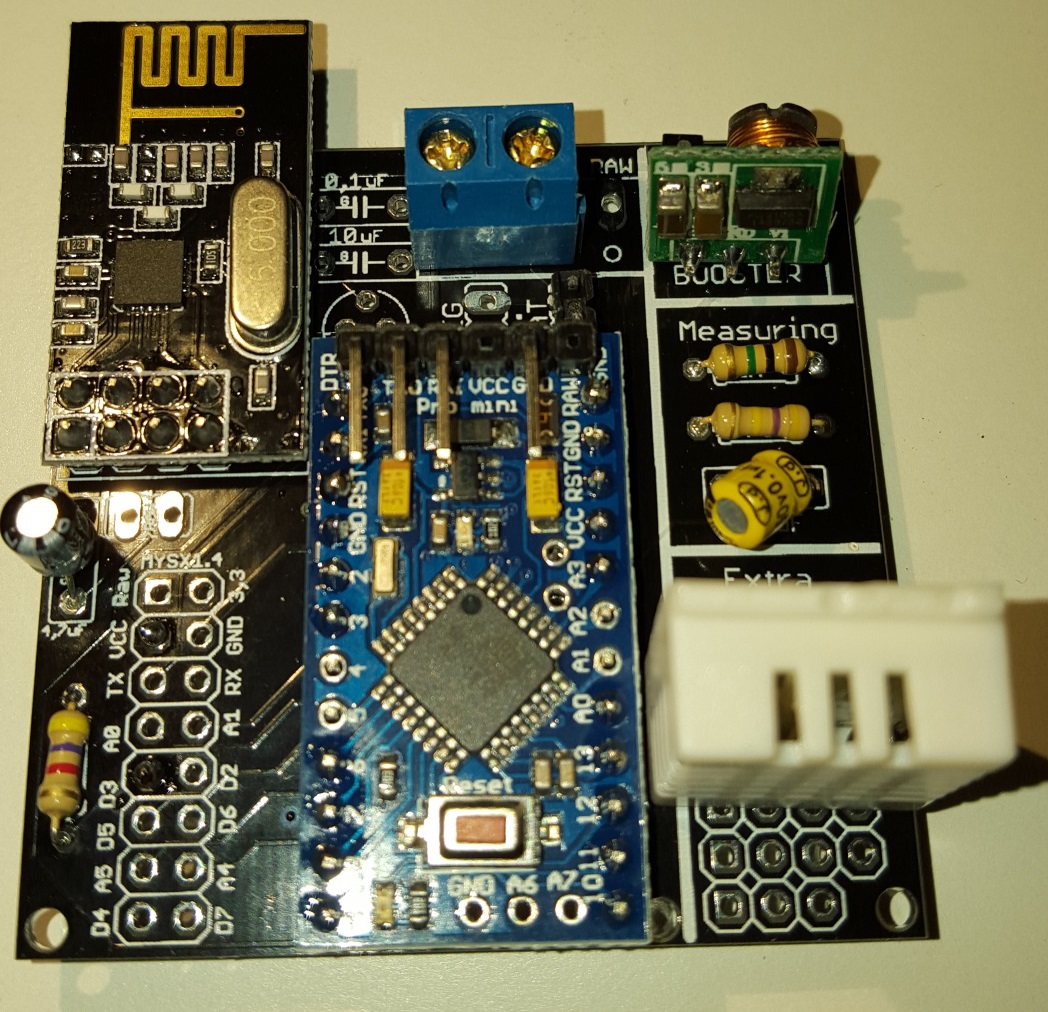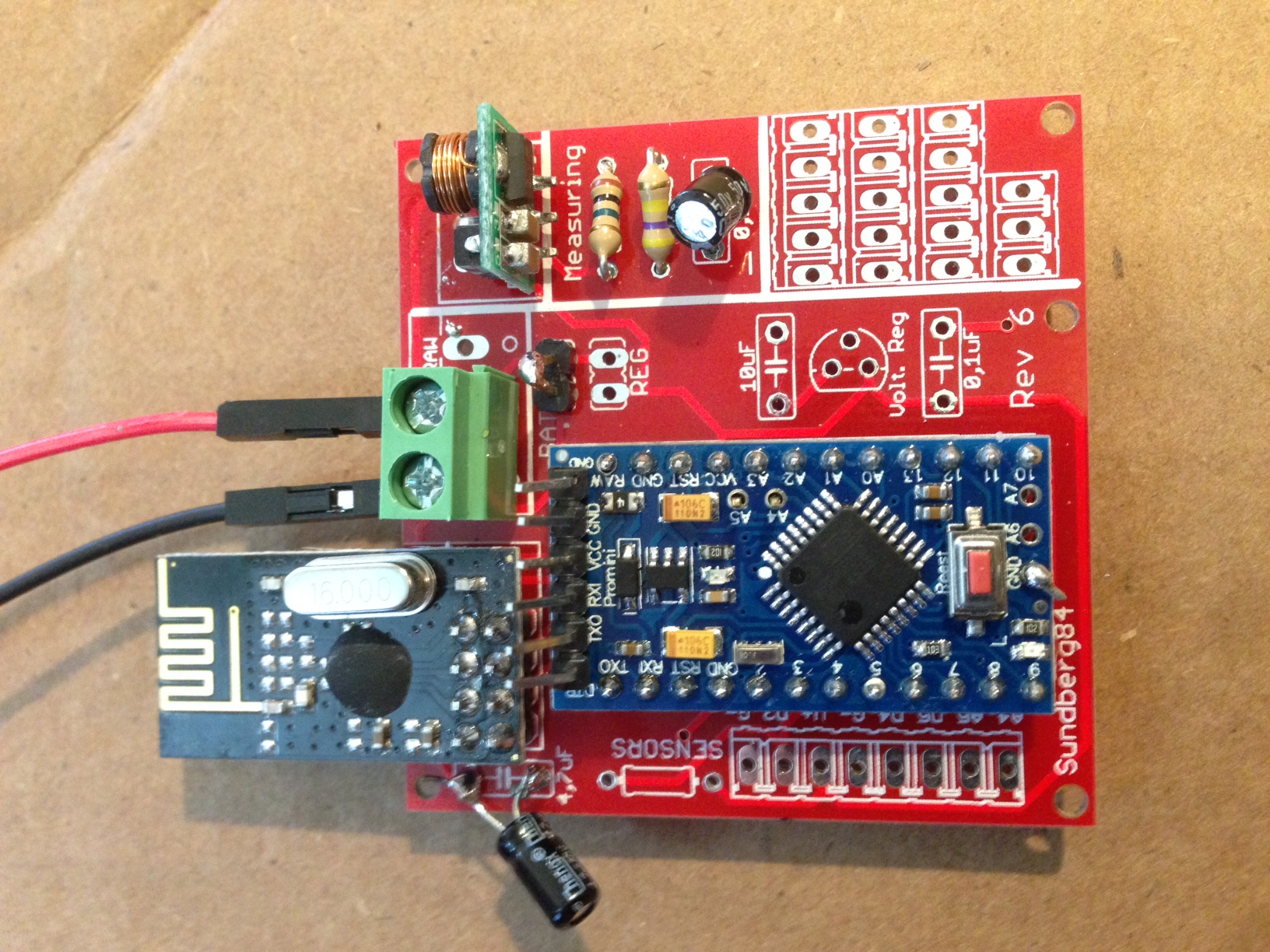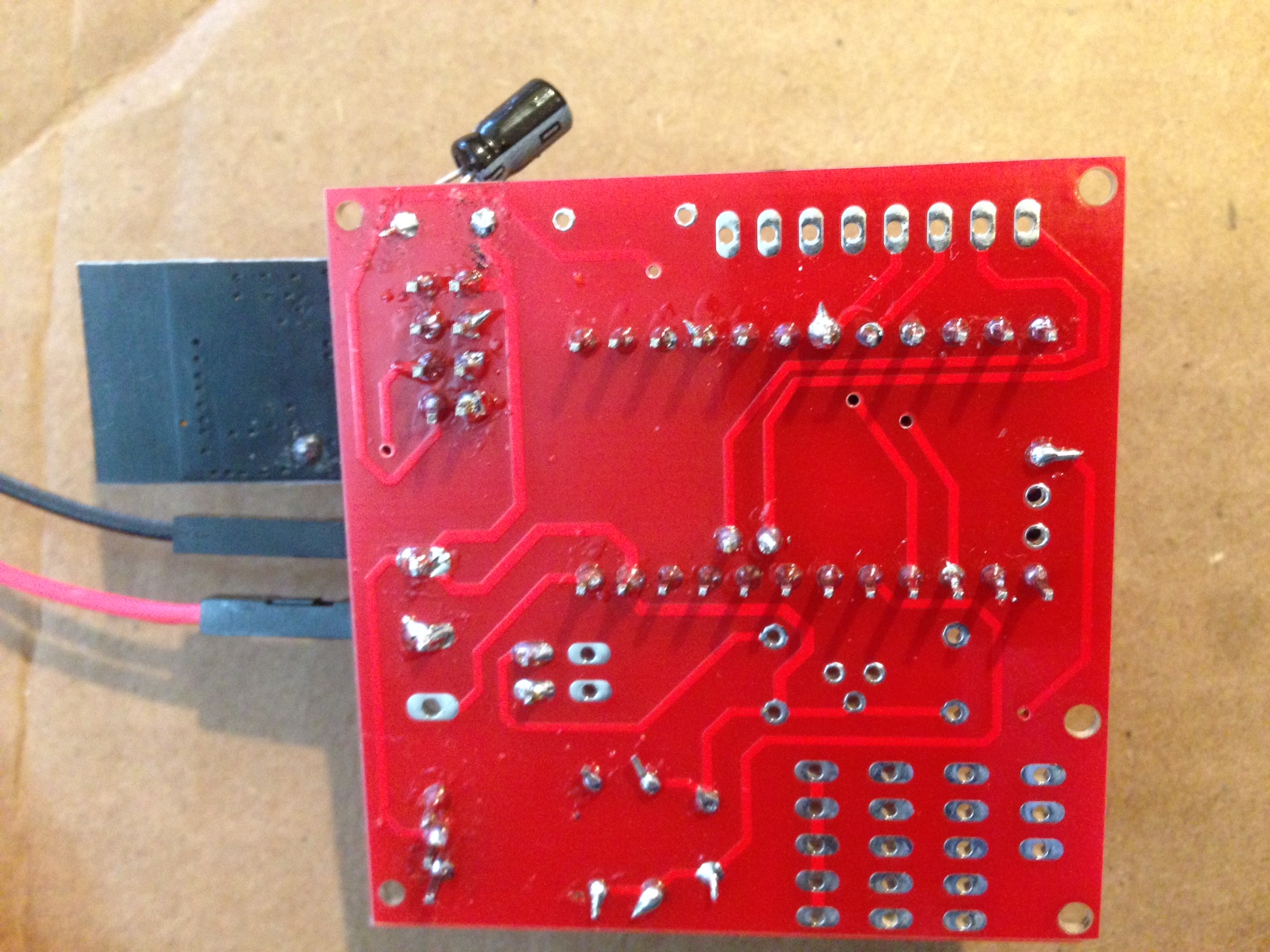💬 Easy/Newbie PCB for MySensors
-
If you use the FTDI connector, make sure its the 3.3v and connect it to Gnd/Pwr on the PCB and not Arduino FDTI connector.
You could just exclude those pins and connect a battery directly and use that as power and the FDTI as programmer/serial debug onlyBat or Reg is nessecary!
See this picture for battery use: https://www.openhardware.io/view/4/EasyNewbie-PCB-for-MySensors
https://www.openhardware.io/uploads/568ed84b60aa3f8965fbf095/image/3.jpg
All components in the image is needed (except battery measurment).
If you dont want to use booster you need to bypass that one with a wire/jumper (or set the jumper on REG instead of BAT but that kills the logic).The battery doesnt "need" the 0,1uF but see here:https://www.mysensors.org/build/battery
"The tap point could be bypassed with a 0.1 uF capacitor to keep the noise level low, at this otherwise high impedance point. "@sundberg84 said:
If you use the FTDI connector, make sure its the 3.3v and connect it to Gnd/Pwr on the PCB and not Arduino FDTI connector.
You could just exclude those pins and connect a battery directly and use that as power and the FDTI as programmer/serial debug onlyBat or Reg is nessecary!
See this picture for battery use: https://www.openhardware.io/view/4/EasyNewbie-PCB-for-MySensors
https://www.openhardware.io/uploads/568ed84b60aa3f8965fbf095/image/3.jpg
All components in the image is needed (except battery measurment).
If you dont want to use booster you need to bypass that one with a wire/jumper (or set the jumper on REG instead of BAT but that kills the logic).The battery doesnt "need" the 0,1uF but see here:https://www.mysensors.org/build/battery
"The tap point could be bypassed with a 0.1 uF capacitor to keep the noise level low, at this otherwise high impedance point. " -
@chuckconnors Well, it is possible... you can always hard wire/bypass stuff with wires... its possible.
See @BastienVH for minimun req. 3.3v. In bat. operations you feed the radio directly from batteries - less noice and radio can handle down to 0.9V (i think) so its not a problem. You need the booster for sensors and arduino requiers 3.3v to run. You can also feed 3.3v directly to VCC on the PCB if you have that regulated. Then you can just add jumper to reg.If you tell me exactly what you want to do i can help you and explain what you need and how to wire it. With your setup now like you described and you run that on 3v batteries it will be dead within a week.
If you want battery power - you should go with 3.3v arduino (advantage: last longer)
If you have regulated 5v (like from a phone charger) use 5v arduino (advantage: smaller PCB) -
First battery node with rev 8 is up and running... need to test 5v version as well but looks good so far

-
Hi,
I've received boards from dirtypcb, it looks pretty good! Very nice design!Just have a few questions:
- May I use 78L33 voltage regulator instead of LE33ACZ?
- Do you know what is the RAW input tollerance of Pro Mini 3.3V (ebay one, not genuine one)?
I'm thinking of attach temperature sensor to my PIRs in my home and feed it parasitically from PIR (~13VDC). Do you think is it possible?
-
Hi Lukasz!
-
78L33 is a 3.3v regulator so yes, but is different pins depending on which version you have so you need to check where you put the pins. From left Vout, Gnd and Vin should be connected to the PCB. Compare it with LE33 pinouts.
-
In theory it should be 12v BUT its a fact that manu clones cant handle that. I would not go above 9v.
-
-
Hi Lukasz!
-
78L33 is a 3.3v regulator so yes, but is different pins depending on which version you have so you need to check where you put the pins. From left Vout, Gnd and Vin should be connected to the PCB. Compare it with LE33 pinouts.
-
In theory it should be 12v BUT its a fact that manu clones cant handle that. I would not go above 9v.
- Ok I will check pinouts
- I understand. So what is the best way in your opinion to feed node parasitically in safe manner? Use voltage regulator to step down voltage to safe 3.3v? Should I expect any significant heat? I'm aware of heat becouse it can trigger false alarm of my PIR
-
-
I would go with a voltage regulator from your 13v to 5 or 3.3v depending on which arduino you buy. I would connect this to PWR on the pcb and avoid using arduino internal voltage regulator (avoid use of two voltage regulators).
-
Thanks sundberg84, I will give a try.
One last question. I didn't find any note in BOM list. May I use ceramic caps instead of electrolitic ones?
I 'm not able to find electrolitic 0.1uF caps at my local store. -
Yes, you can replace it with a ceramic. There are alot to read about the differences on the net.
-
@Dombo71 - Hi!
The BOM is complete, all capacitors needed and its values are found in the BOM tab.
Since caps are so cheap and common i wont specify any link since you can find theme anywhere. -
Anyone from the Netherlands who ordered a pack of the rev.8 boards? How long did it take to be delivered?
The status update on dirtypcbs.com saysShipped on 27 Jan 2016and I can't wait until I receive them! :) -
Anyone from the Netherlands who ordered a pack of the rev.8 boards? How long did it take to be delivered?
The status update on dirtypcbs.com saysShipped on 27 Jan 2016and I can't wait until I receive them! :) -
Anyone from the Netherlands who ordered a pack of the rev.8 boards? How long did it take to be delivered?
The status update on dirtypcbs.com saysShipped on 27 Jan 2016and I can't wait until I receive them! :)@lxz Chinese New Year Holiday is just over, there seems to be quite a backlog for items ordered in january. It depends on some luck, to Antwerpen took around 6 weeks.
-
I love this PCB. It makes things so much easier. I am having a little problem with the battery version though. I think I've got it wired up right. I've got the jumper. I've got the booster. But, when I plug in a battery (I've tried a 3.7 volt battery, outputting 3.3v - the one from the solar weather station project, and 2 or 4 AA batteries), I get a "Radio Init Fail" message in the serial monitor. Also, the LED at the back, the one near the reset button, does not light brightly. It initially flashes brightly, then nothing.
I've wired it up two different times for the battery setup, and with neither am I getting the live radio.
I am able to get a good radio with the 5v setup.


-
Hi!
@gentrfam
It looks correctly wired. The radio (when bat jumper is selected) is feed directly from the battery, so you need to keep within the specs of the radio (0,9v- 3.6v).
First thing I would do is measure volt over radio. Also measure volt over the arduino. Working backwards can give you a clue where it fails if its a power problem.My wild guess is that either its not a genuine/working NRF radio, or you have a cold/bad solder point on arduino and/or radio.
I always check my radio before soldering them... a while back I counted that I have ordered 33 radios from Ebay and 3 of them was broken so far. So i have a Easy board just for radiocheck loaded with timeaware sketch.
-
Hi!
@gentrfam
It looks correctly wired. The radio (when bat jumper is selected) is feed directly from the battery, so you need to keep within the specs of the radio (0,9v- 3.6v).
First thing I would do is measure volt over radio. Also measure volt over the arduino. Working backwards can give you a clue where it fails if its a power problem.My wild guess is that either its not a genuine/working NRF radio, or you have a cold/bad solder point on arduino and/or radio.
I always check my radio before soldering them... a while back I counted that I have ordered 33 radios from Ebay and 3 of them was broken so far. So i have a Easy board just for radiocheck loaded with timeaware sketch.
@sundberg84 Thank you. I checked, and out of the solar-powered battery, I'm actually just out of the radio spec - 3.7-4.0v. I'm going to try with a new radio, and a smaller battery to see if I fried this radio.
In the meantime, I tried to run the battery through an LE33 regulator on a breadboard. (Eventually, I'd like to run the solar-battery through the measuring circuitry on the PCB.) Any idea why the LE33 would be outputting 0.6v?
Thanks for your help. I'm afraid I'm a complete and total noob on this.
-
No, check incoming voltage to the LE33 - is this correct?
Is the caps oriented (ground) correcly? (if you have any).
Broken?
